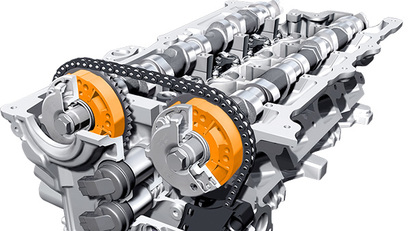
VANOS / Double-VANOS
Smoother idling, greater torque, elastic power: double-VANOS varies the camshaft timing to optimise power output throughout the rev range. Whatever your speed, you benefit from better performance, improved fuel efficiency and lower emissions.
The name VANOS is derived from the German term "variable Nockenwellensteuerung", meaning variable camshaft control. The double-VANOS system continuously adjusts the camshaft positions for both the intake and the exhaust valves. This results in significantly higher torque at low engine speeds and more power at higher engine speeds, while also reducing fuel consumption and emissions.
At lower engine speeds, the position of the camshaft is moved so the valves are opened later, as this improves idling quality and smooth power development. As the engine speed increases, the valves are opened earlier: this enhances torque, reduces fuel consumption and lowers emissions. At high engine speeds, the valves are opened later again, because this allows full power delivery.
Double-VANOS also controls the amount of exhaust gas that is re-circulated back to the intake manifold, enhancing fuel economy. The system uses a special set of parameters in the engine's warming-up phase in order to help the catalytic converter reach its ideal operating temperature more quickly, lowering emissions. The entire process is controlled by the vehicle's Digital Motor Electronics (DME). BMW first introduced the breakthrough VANOS technology in 1992. Double-VANOS entered production in 1997.
Back to list
The name VANOS is derived from the German term "variable Nockenwellensteuerung", meaning variable camshaft control. The double-VANOS system continuously adjusts the camshaft positions for both the intake and the exhaust valves. This results in significantly higher torque at low engine speeds and more power at higher engine speeds, while also reducing fuel consumption and emissions.
At lower engine speeds, the position of the camshaft is moved so the valves are opened later, as this improves idling quality and smooth power development. As the engine speed increases, the valves are opened earlier: this enhances torque, reduces fuel consumption and lowers emissions. At high engine speeds, the valves are opened later again, because this allows full power delivery.
Double-VANOS also controls the amount of exhaust gas that is re-circulated back to the intake manifold, enhancing fuel economy. The system uses a special set of parameters in the engine's warming-up phase in order to help the catalytic converter reach its ideal operating temperature more quickly, lowering emissions. The entire process is controlled by the vehicle's Digital Motor Electronics (DME). BMW first introduced the breakthrough VANOS technology in 1992. Double-VANOS entered production in 1997.